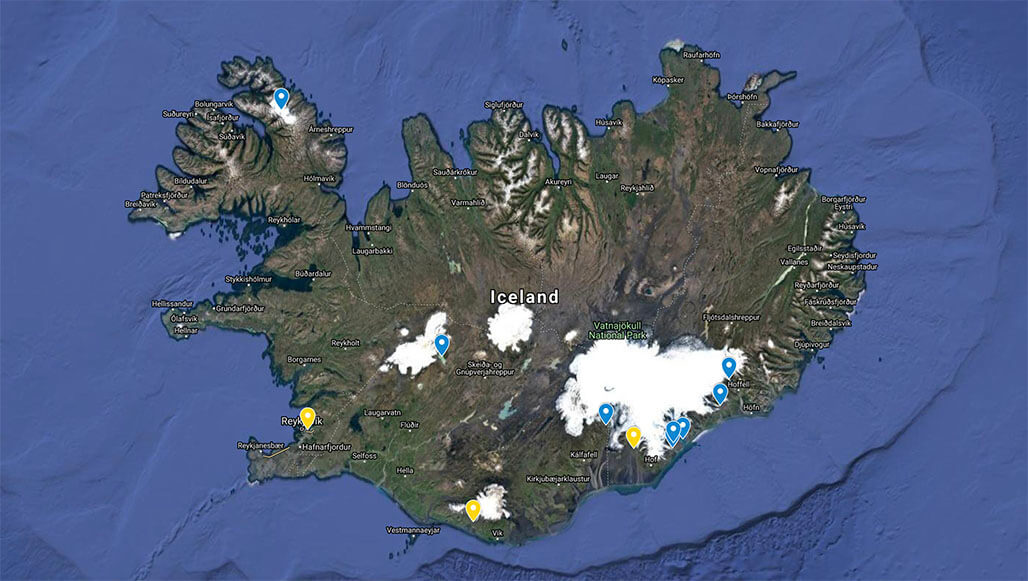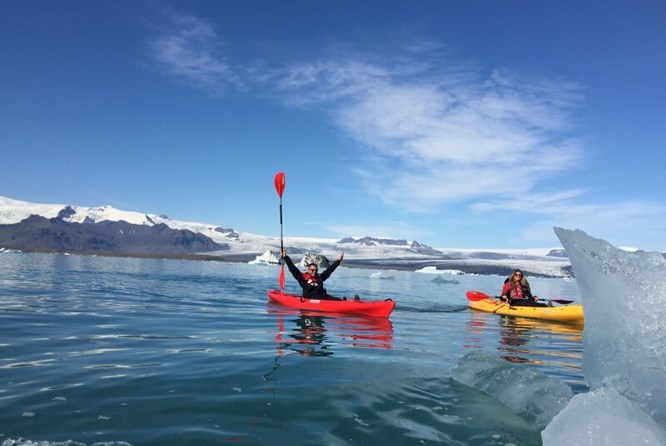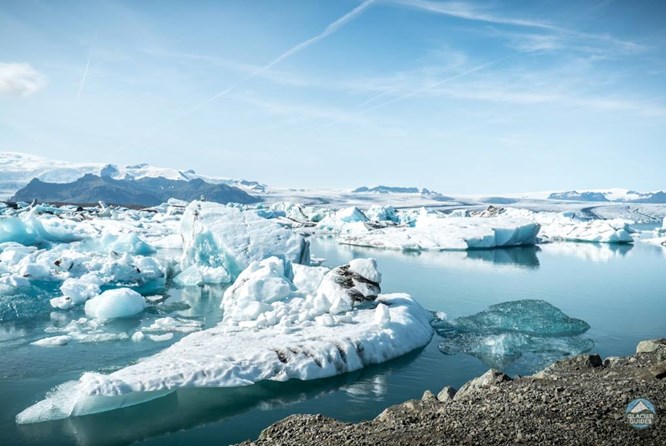Glacier Lagoons in Iceland
Iceland is famous for its ethereal landscapes that include a range of natural awe-inspiring attractions. Glacier lagoons are without a doubt the most impressive kind in this category. And you are probably wondering which glacier lagoon is best to travel to when you only have a few days to visit Iceland? For those who have ample time, where to find a quieter but equally beautiful glacier lagoon when you want to avoid the crowd and see Iceland from a less touristy perspective? Or, simply, what are the best glacier lagoon tours in Iceland that can completely quench your thirst for wanderlust? Follow this comprehensive guide and it’s going to be a fun ride!
Video From: Jokulsarlon Glacier Lagoon | Amphibian Boat Tour
What is a Glacier Lagoon?
Glacier lagoon, or glacial lake, is a natural phenomenon of glacial meltwater filling out the eroded space at the foot of a glacier. It started roughly about 10,000 years ago when the last glacial period came to the end. The move and flow of a glacier eroded the soil and the sediment around it, leaving the land with grooves and hollows. These natural indentations catch glacial meltwater when the ice caps started to retreat, creating glacial lakes where the calved ice chunks also stay afloat.
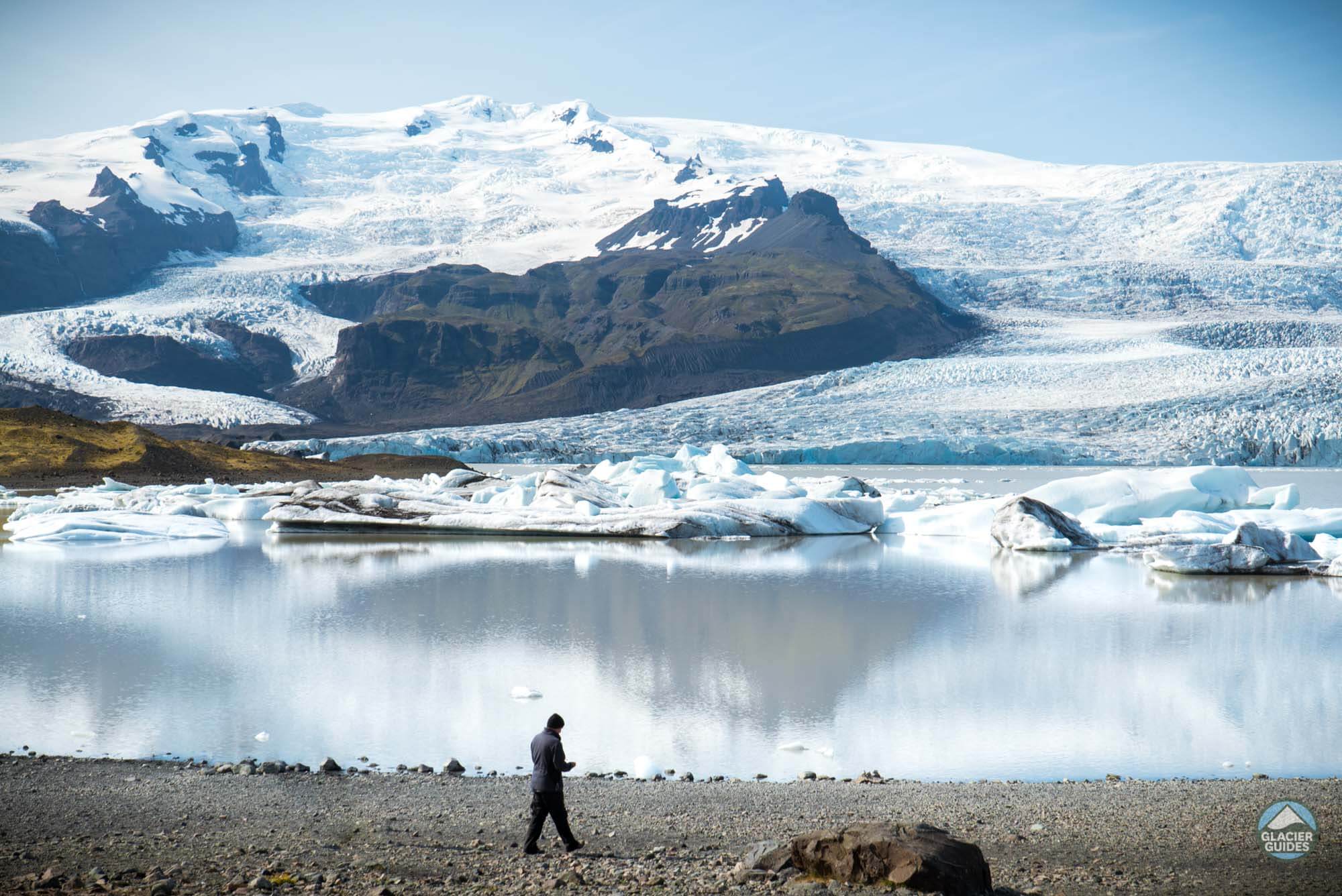
One of the most noteworthy features about glacier lagoons is the coloration of glacial ice. It has to do with how glacial ice is formed and the interplay between glacial ice and climate as well as with the geological environment. In Iceland, you will easily spot some black and brownish stripes on the floating ice chunks in the glacier lagoons. Black layers are unique since they can only be seen in Iceland due to the relatively frequent volcanic activities; and the brownish stripes are the sediments picked up by the glaciers as they move.
Most glacial lakes in the world are beautiful and serene because of the color of water, their surroundings, and the ice-capped mountains not far away, but there are glacial lakes that can be dangerous for its neighboring human communities. Since glacial lakes can act as natural plumbing system, when they don’t work due to any abrupt bursts of intense melting or prolonged melting, they can immediately turn into a risk.
Fortunately, in Iceland, the glacier lagoons are usually located in remote areas where the settings are absolutely natural and untainted. The most renowned Jokulsarlon glacier lagoon is the crown jewel of all natural attractions sitting at the tip of Southeast Iceland.
Video: Nepal's the most dangerous glacial lake
How Many Glacier Lagoons are there in Iceland?
The number of glacier lagoons in Iceland is increasing over the years, and the existing ones are expanding at a dramatic rate. Although the exact number is uncertain, more than half a dozen glacial lakes are mentioned in this detailed guide and most of them are accessible for visitors. Every year from May to October, visitors have the option of getting on a boat tour cruising between the huge, floating icebergs in some of the glacial lakes, and the view is especially spectacular in Jokulsarlon glacier lagoon. It’s the best time of a year to engage yourself with the captivating natural allure that’s so incredible and transient. More amazingly, Jokulsarlon isn’t the only mesmerizing glacial lake that the mighty Vatnajokull glacier mothers, there are several other glacial lakes dotted on its western, eastern, and southern sides that are absolutely fabulous for visitors to see the utterly stunning icebergs.
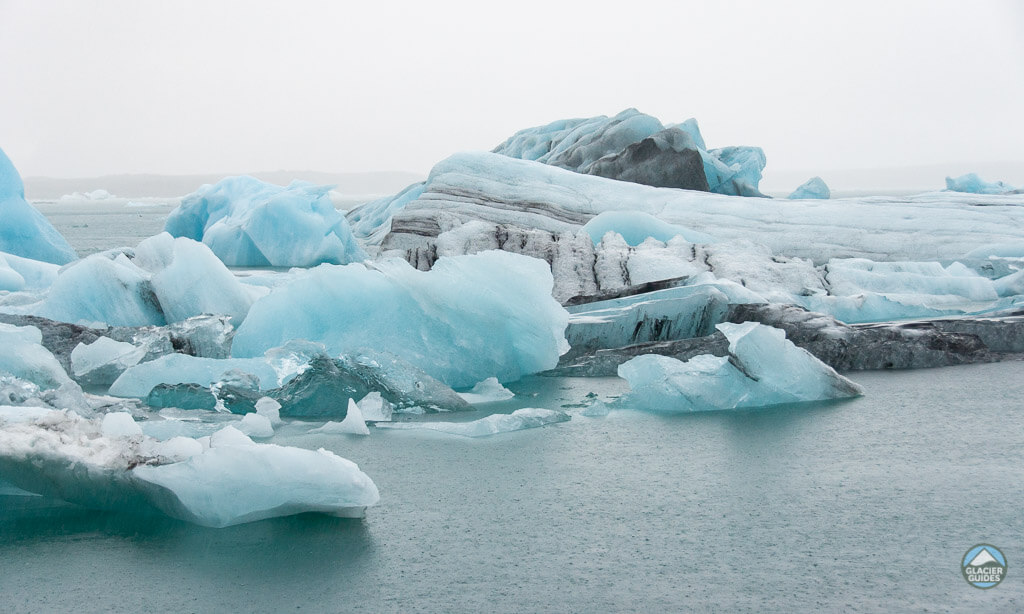
Europe’s most voluminous ice cap Vatnajokull is also Iceland’s largest glacier. With its averaged ice thickness of 400 meters (1300 ft), Vatnajokull hosts the highest peak of Iceland - Hvannadalshnukur, reaching up to 2109.6 meters (6921 ft) - and numerous splendid outlet glaciers that are essential to creating glacial lakes.
As a well-known fact, Jokulsarlon sits on the southeast edge of Vatnajokull, and it’s adored by the Icelanders as the crown jewel ever since its formation in the early 20th century. In the same area, there are two other astonishing glacier lagoons perched on the edge of Breidamerkursandur that spans between Kvia river and Fellsa river. These two glacier lagoons are less crowded, and together they stand strong in the cultural and recreational sides of Iceland for nature lovers, photographers and adventurers.
Breidamerkursandur spans between Kvia river and Fellsa river
Fjallsarlon Glacier Lagoon
Fjallsarlon glacier lagoon is a stunning lake hidden off the beaten path that’s only about 10 kilometers southwest to Jokulsarlon. Its absolute tranquility is outstandingly captivating for nature lovers to enjoy the primitive landscapes of Iceland. Visiting Fjallsarlon is a perfect detour for a moment of solitude while almost everyone else is possibly heading to Jokulsarlon.
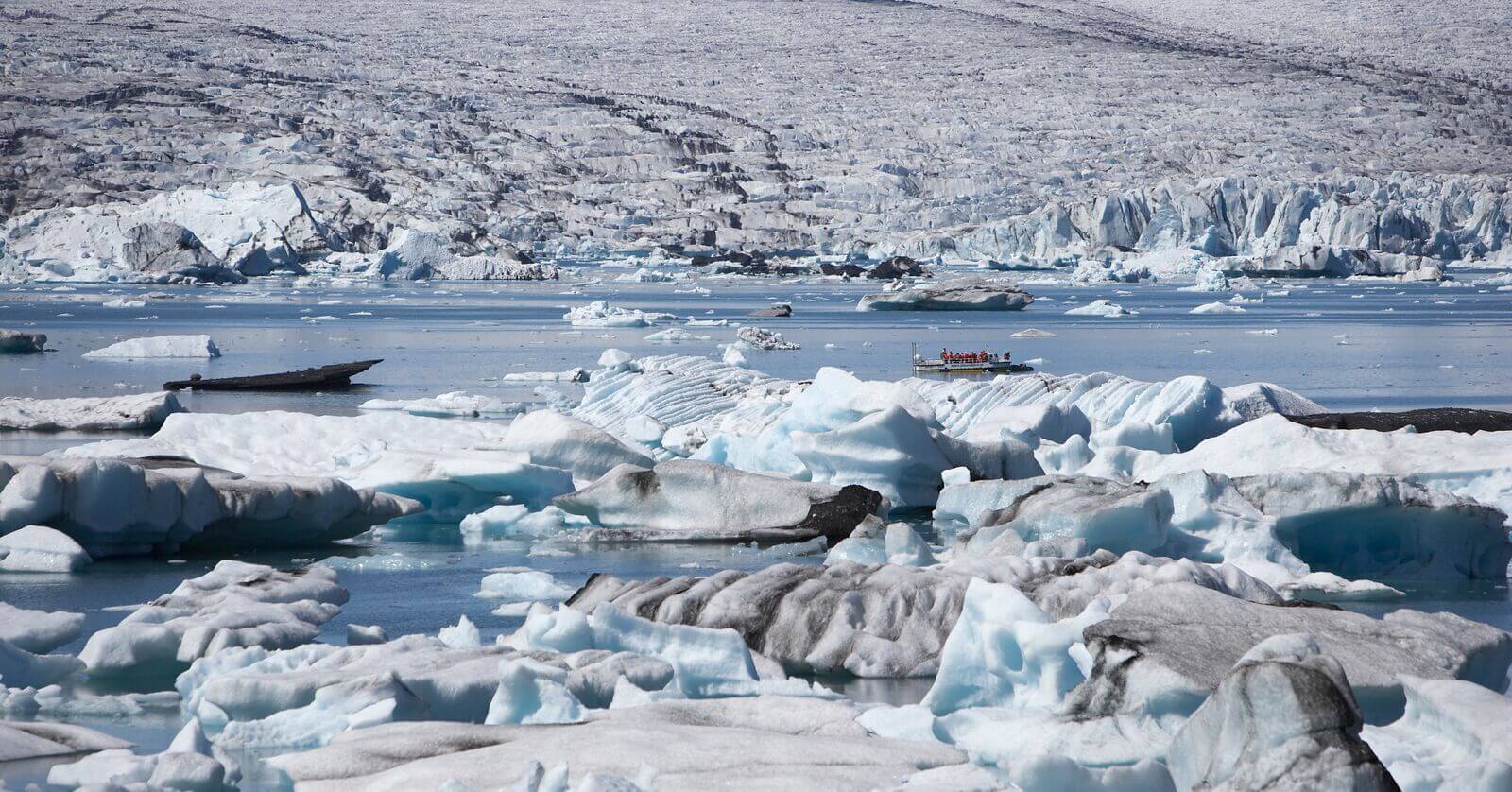
People always say Fjallsarlon is a muddy version of Jokulsarlon. It’s true because the appearances of the water at Fjallsarlon is not as clear as Jokulsarlon since the lake is not as deep as Jokulsarlon. When a chunk of ice breaks off the glacier tongue and starts moving in the lake, the sheer size of the iceberg will stir the mud at the bottom of the lake making the water opaque. But due to Fjallsarlon’s smaller size and less popularity, a glacier kayaking adventure or a Zodiac boat tour can grant you the exclusivity while traveling in such a surreal environment in the middle of the pure serenity and the dramatic contrast between land and water.
After the boat ride in between icebergs, you can further experience the glacier by stepping on the endless ice cap and see the jagged ice up close. Fjallsarlon has also attracted artists like the popular rock band Kaleo to come here for their creative inspiration.
The popular rock band Kaleo did MV at Fjallsarlon
Breiðárlón Glacier Lagoon
Moving towards north from Fjallsarlon, you will find a larger glacier lagoon near the gorgeous glacier tongue of Breiðamerkurjökull that’s stretching out from the south end of the mighty Vatnajokull. It’s named after the glacier tongue with a lot of great features offering an awesome alternative for travelers who’d enjoy a tranquil scene in the crisp air of Iceland. Breidarlon glacier lagoon is connected with Fjallsarlon by a little river Breida that flows with an alluring silvery color. Breidarlon glacier lagoon is twice as large as its connected neighbor in the size of more than six square kilometers, and it’s getting bigger and bigger every year.
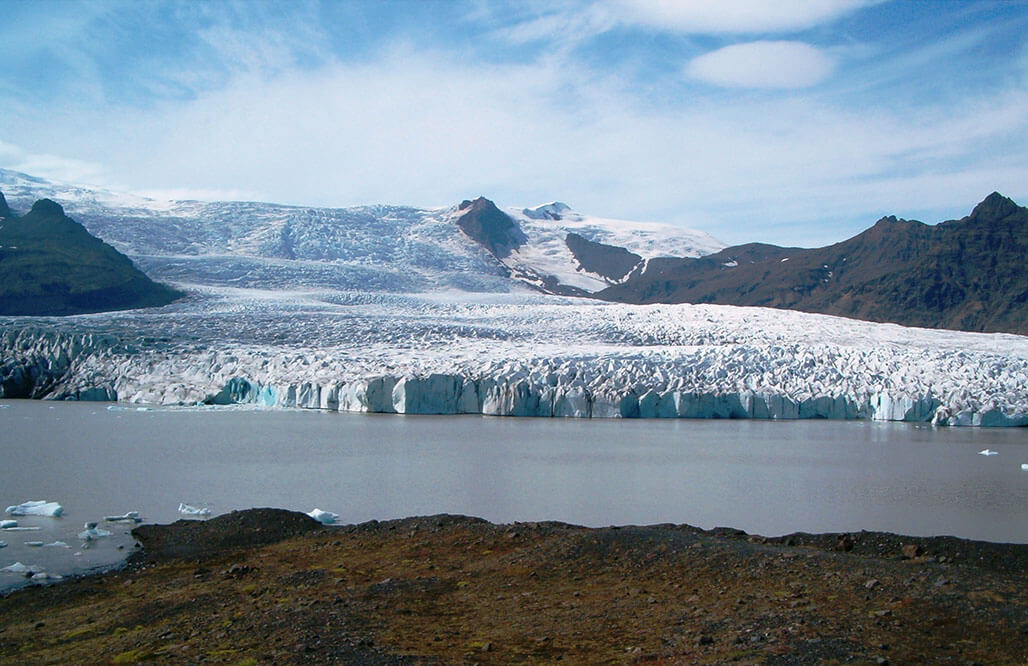
The extraordinary view of Breidarlon and the retreating outlet glacier. (Photo credit to Bromr, Creative Commons)
Jokulsarlon Glacier Lagoon
The most famous glacier lagoon on Breiðamerkursandur is Jokulsarlon glacier lagoon, which is considered as the crown jewel of the Icelandic natural attractions.
The glorious cerulean body of water sits right at the bottom of the Breiðamerkurjökull glacier tongue. The glacial meltwater began to accumulate since the 1930s when the glacier tongue started to retreat. Now, it’s the deepest natural lake in Iceland with a maximum depth of 248 meters (814 feet) and an area of 18 square kilometers (7 sq-mi), which is considered as the largest natural glacial lake in Southeast Iceland.

Wildlife at Jokulsarlon Glacier Lagoon with Beautiful Icebergs Floating Around
As the glacier tongue started receding from the edge of the North Atlantic Ocean, huge ice chunks began to calve from the glacier before they ended up drifting in the huge lagoon on their way out to the ocean. Smaller ice cubes get stuck on the black sand beach when their melting process nearly comes to the end, making the entire beach an unforgettable scene resembling the mesmerizingly shining diamonds spread on acres of natural black velvet.
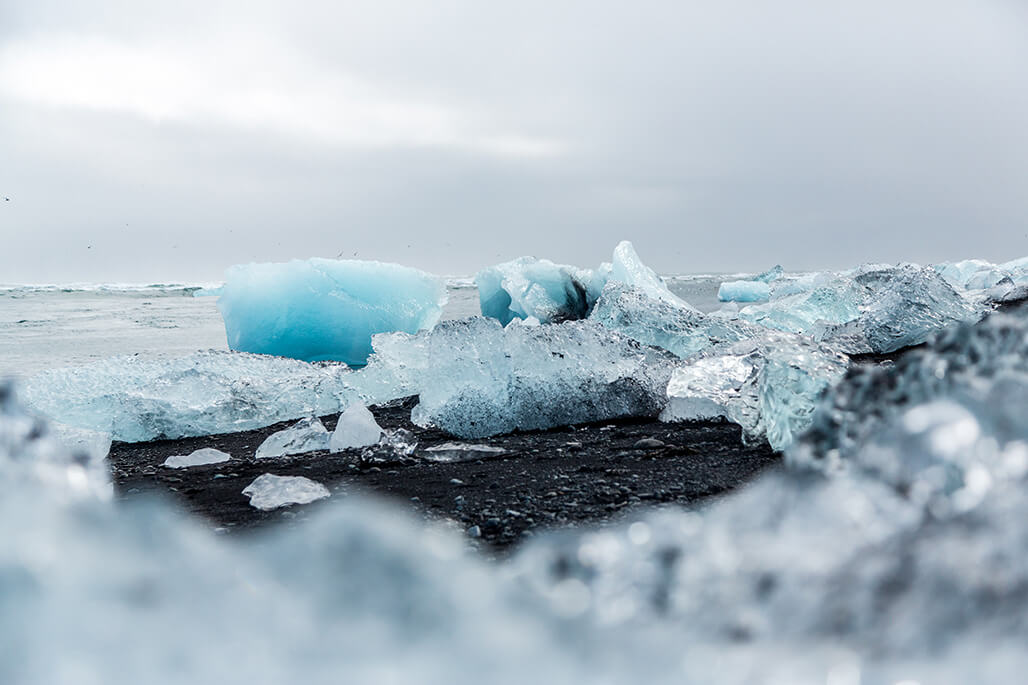
Diamond Beach of Jokulsarlon Glacier Lagoon, South Iceland
The best way to see and feel the sheer size of the icebergs is to go on a boat ride. You can get intimately close to the light blue and milky-white natural masterpieces by an engaging zodiac boat trip. From time to time, visitors can see a colony of seals relaxing on icebergs or swimming in the blue water of the glacier lagoon. Another type of boat trip is operated on the amphibian boat and on the tour visitors get to hold and taste an ancient iceberg that once was a part of the mighty Vatnajokull.
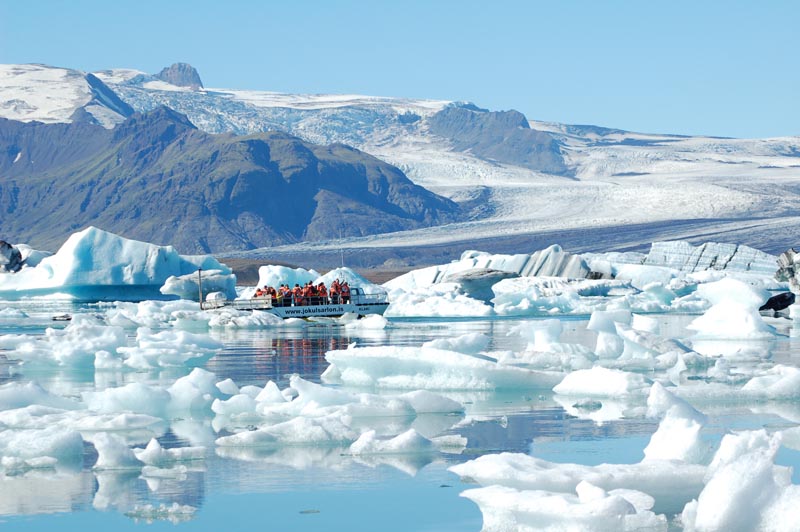
Sailing in Jokulsarlon Glacier Lagoon on an Amphibian Boat Tour, South Iceland
There are so many fun facts about Jokulsarlon and the Diamond beach that you will learn from your guide during the boat trips. One of the most popular topics about Jokulsarlon can be how fabulous and versatile this place is for movie makers and commercial crews. Several movies have done scenes in this place such as “Die Another Day,” “A View to a Kill,” “Tomb Raider,” and “Batman Begins.” The high-end cosmetic brand La Mer also did a commercial here featuring Kate Hudson that highlighted the freshness, cleanliness, and purity of the astounding and healing Jokulsarlon.
On a good day in summer, you can also take a walk around the lake or get on the hilly area to appreciate the view of icebergs and the glacier tongue afar, it’s not recommended to do so in winter though, since the gravel ground can be very slippery.
Except walking around the lagoon, you can also experience the therapeutic side of Jokulsarlon by kayaking. It’s way more fun and adventurous because you get to see the icebergs and the glacial lake from an uncommon perspective. In winter, Jokulsarlon is also the location for glacier ice caving tours. The trip to Vantajokull’s most glorious Crystal Ice Cave starts right here at Jokulsarlon’s parking lot.
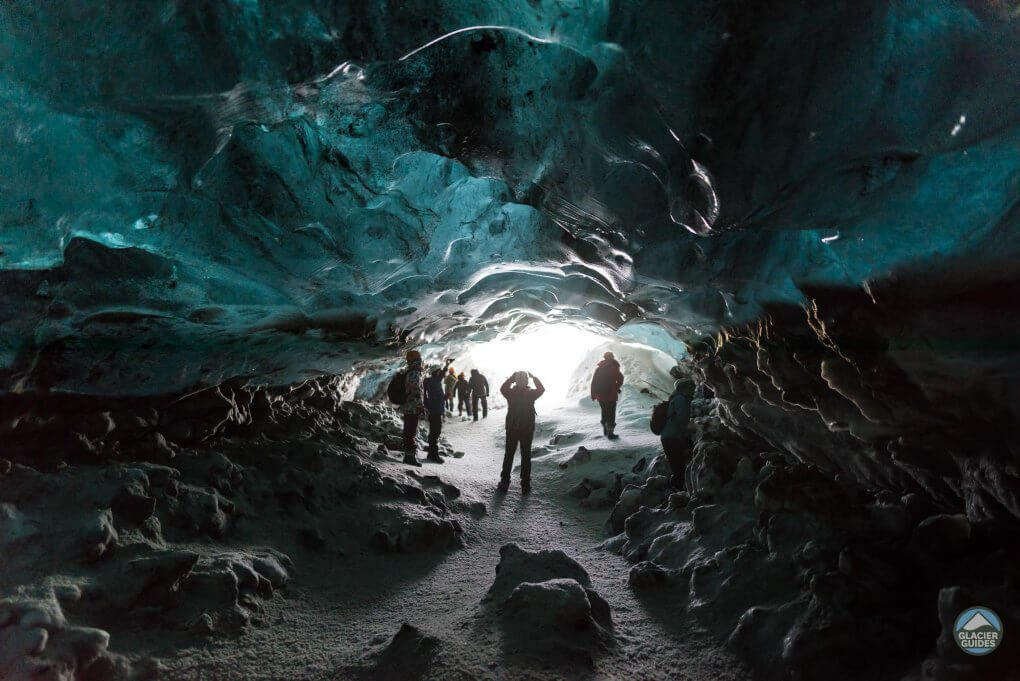
Visiting Crystal Ice Cave at Vatnajokull Glacier From Jokularlon
Heinabergslon Glacier Lagoon
Heinabergslon is a less-known glacial lake situated in South Iceland, fed by the glacial meltwater from Heinabergsjokull, an outlet glacier from Vatnajokull.
Although less popular, it’s perfect for a trip off the beaten road when you eager to get out of the tourist crowd and enjoy a moment of solitude. It’s about 30-minute drive east of Jokulsarlon via Ring Road, aka Route 1.
Much similar to Fjallsarlon, Heinabergslon is a bit muddy with super-sized icebergs floating in the lake, making a kayaking tour worthwhile. Kayakers can paddle all the way up close to Heinabergsjokull outlet glacier and immerse themselves in a quiet moment surrounded by the magnificent glacial scenery amidst the raw Icelandic nature.
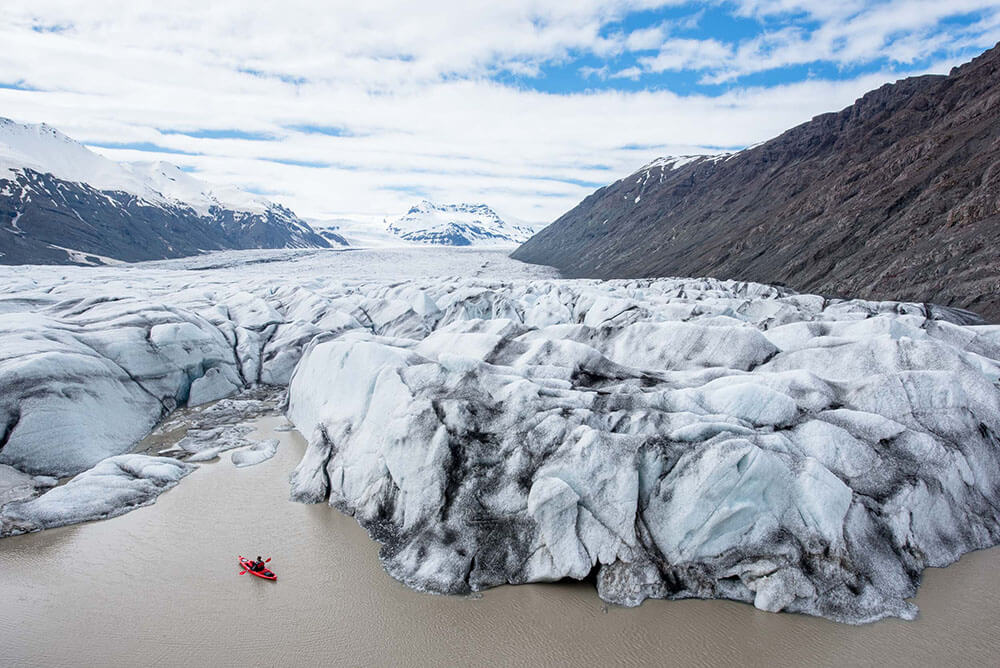
Glacier Kayaking at Heinabergslon Glacier Lagoon, South Iceland
Hoffellslon Glacier Lagoon
Hoffellslon glacier lagoon is located at the end of Hoffellsjokull glacier tongue on the east side of Vatnajokull. Both names are originated from Hoffell referring to a mountainous area and a farmland. Unlike Jokulsarlon, which is an epitome regarding glacier lagoons in Iceland, Hoffellslon lies quietly with a relatively smaller size and muddier colors, making the floating icebergs awe-inspiring. The spectacular mountainous landscapes carved out by earlier glacial movements also make the lagoon’s vicinity a nice place for hiking. Upon reaching the glacier tongue, there are numerous hiking trails to Mt. Geitafell and you can pick one for a day tour before you get to Hofn which is only 15 kilometers away.
Like Jokulsarlon, Hoffellslon is also rich in wildlife. The most commonly seen bird species are Arctic Terns throughout summer, and more amazingly, seals throughout the year.
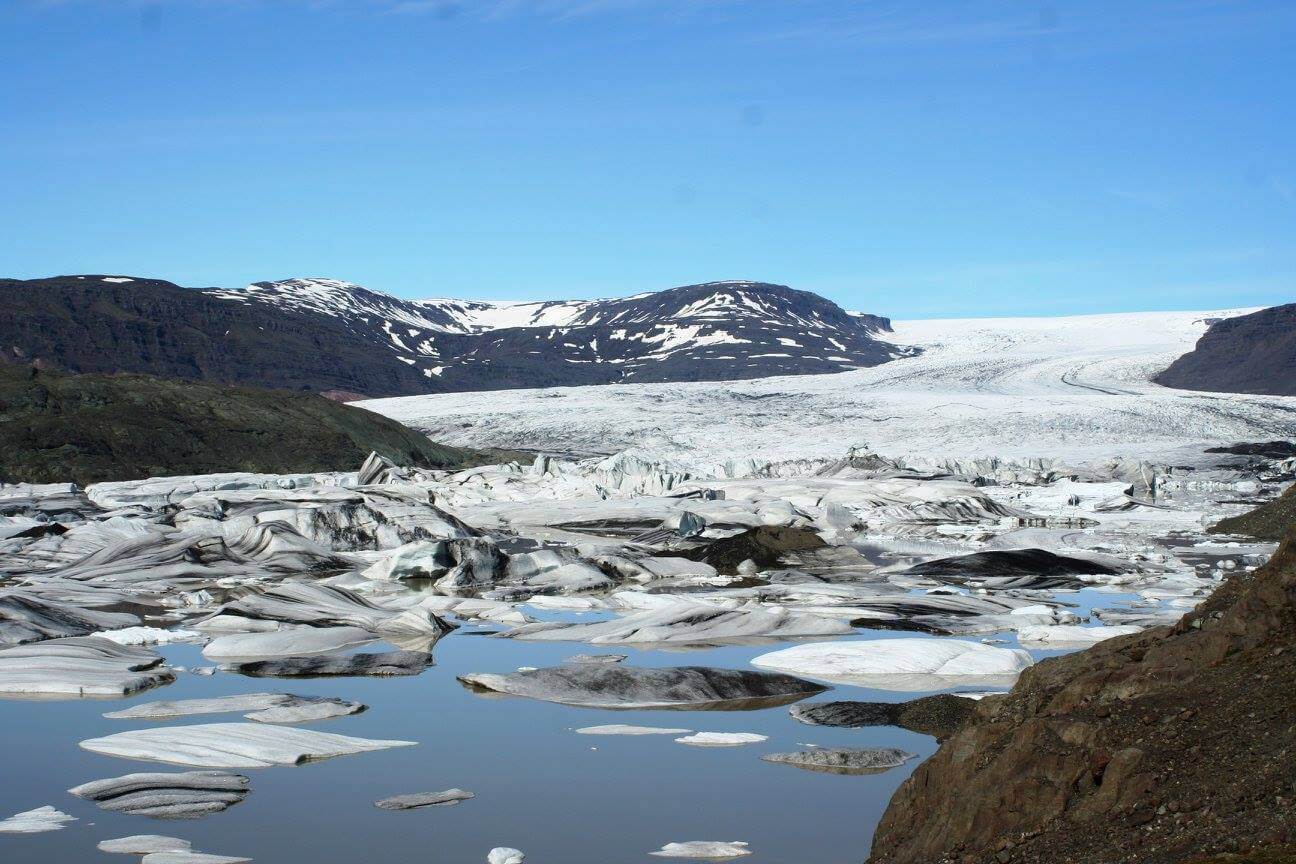
Hoffellslon Glacier Lagoon (Photo via Creative Commons)
Graenalon Glacier Lagoon
Graenalon, or Green Lagoon, is a glacial lake located on the southwest side of Vatnajokull and north-east side of Skaftafell, which is the base for many glacier activities on Vatnajokull with several decent accommodations such as Hof 1. Its surface once measured 18 kilometers during the 20th century. As a constantly changing body of water, Graenalon diminishes as Skeidararjokull retreats. In the last few decades, the thinning and shortening process of the outlet glacier has been draining the water of Graenalon that is, in fact, naturally blocked by the glacier tongue. To sightseer’s dismay, the lake has almost drained entirely. Now its size is merely no more than a pond.
The changes of Graenalon has created a different view for this area with huge icebergs appearing close to the flowing glacier, making the location a unique scene for a brief or a meditative walk. It’s completely easy to reach as a day tour when you begin your trip at Skaftafell.
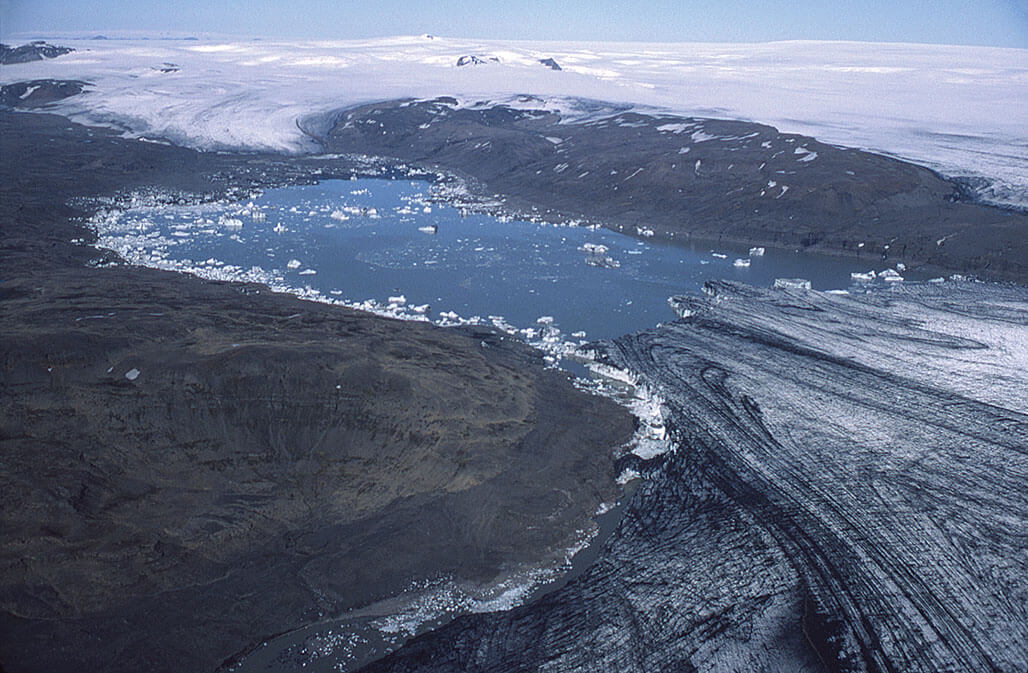
Graenalon Glacier Lagoon (Photo credit USGS Publications Warehouse)
Hvitarvatn
Hvitarvatn, or Hvitarlon, is a beautiful lake on the eastern side of the second largest ice cap in Iceland - the glorious Langjokull. The lake is located in the highlands, and the glacial meltwater from Langjokull streams to the lake before it feeds the most beautiful glacial river Hvita, which is home to Gullfoss waterfall, the most well-known and popular waterfall in Iceland. The lake is only 35 kilometers northeast of the waterfall.
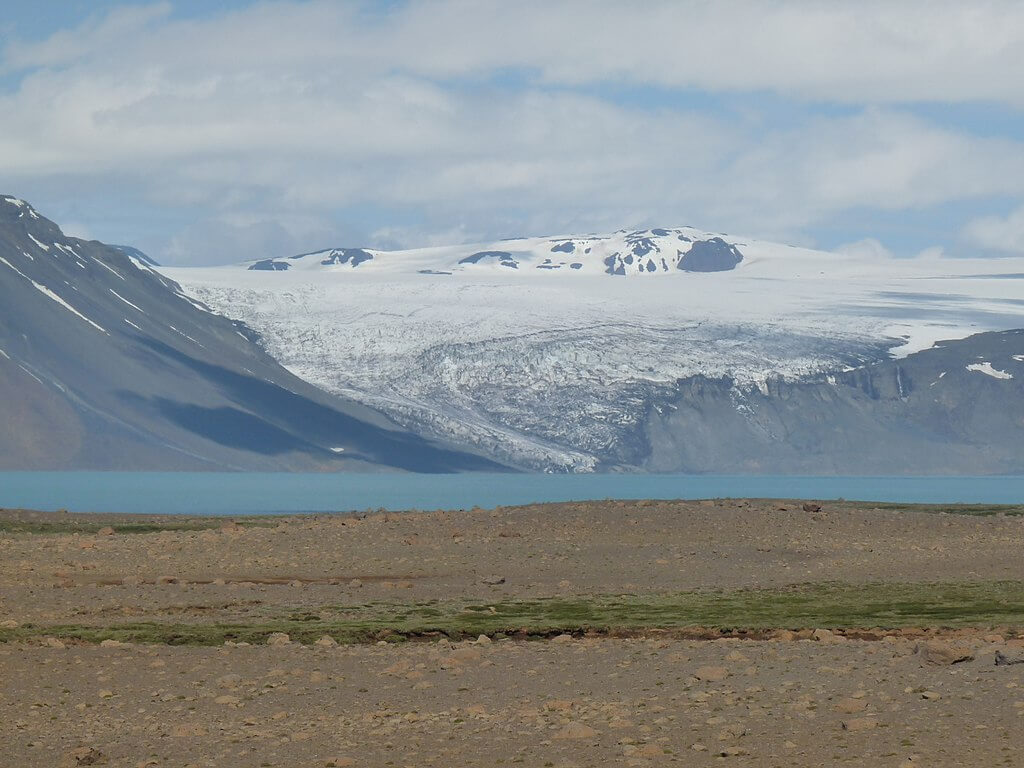
Hvitarvatn Glacier Lagoon (Photo credit to Smiley.toerist via Wikimedia Commons)
The lake covers an area of 30 square kilometers, and its deepest part can reach down to 84 meters from the lake surface. It’s ranked as the sixth largest lake in Iceland. The features of Hvitarvatn are a bit different compared to the glacier lagoon listed above. The lake usually doesn’t have so many icebergs floating in its body of water, and the ice chunks are usually smaller in size. It may be less impressive if you are looking for a typical Icelandic glacier lagoon where huge icebergs move silently, Hvitarvatn is nonetheless a unique also outstanding place when it comes to an unobstructed view taking in the enchanting outlet glacier, mountain, valley , and, of course, a mirror-like lake on a good day.
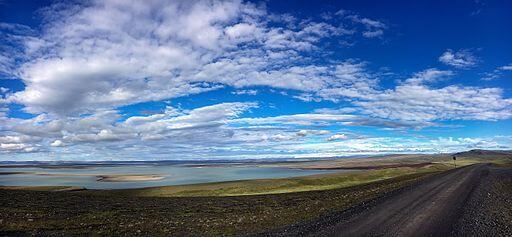
Hvitarvatn Glacier Lagoon (Photo credit to Jerzy Strzelecki via Wikimedia Commons)
Kaldalon Glacier Lagoon
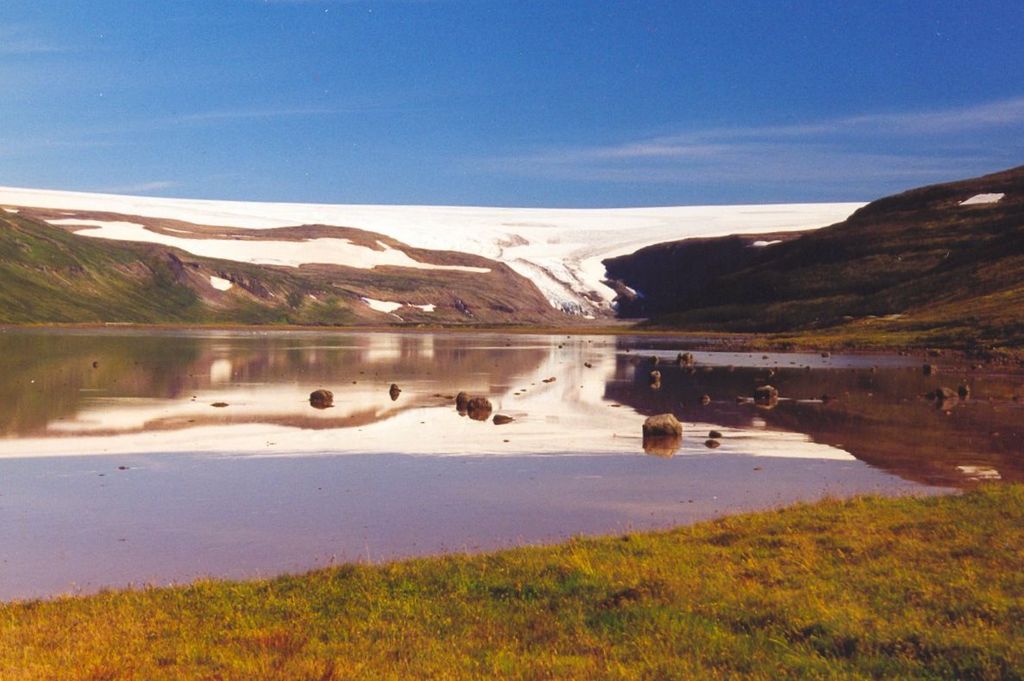
Drangajokull and Kaldalon Glacier Lagoon (Photo credit to AgainErick via Wikimedia Commons)
On the most north-westerly of Iceland, you can find only one glacier in the beautiful Westfjords. Its ice cap is stunningly low-lying since it’s the only glacier in Iceland whose altitude is entirely below 1,000 meters. But the amazing fact doesn’t wrap up here - Drangajokull is also the only ice cap in Iceland that is not retreating, meaning its ice cap is not getting smaller.
These unbelievable facts all contribute to the amazing feature of Kaldalon glacial lake, a seemingly peaceful, almost fjord-like lake elegantly located at the foot of the mighty Drangajokull. This is a rare place for photographers and nature-lovers to go and capture the pristine Arctic sceneries.
To visit Westfjords from Reykjavik, you can choose to drive about 450 kilometers on the paved road, or take a ferry boat from Stykkisholmur at the north tip of the Snaefellsnes Peninsula, and the boat ride is operated from June to August.
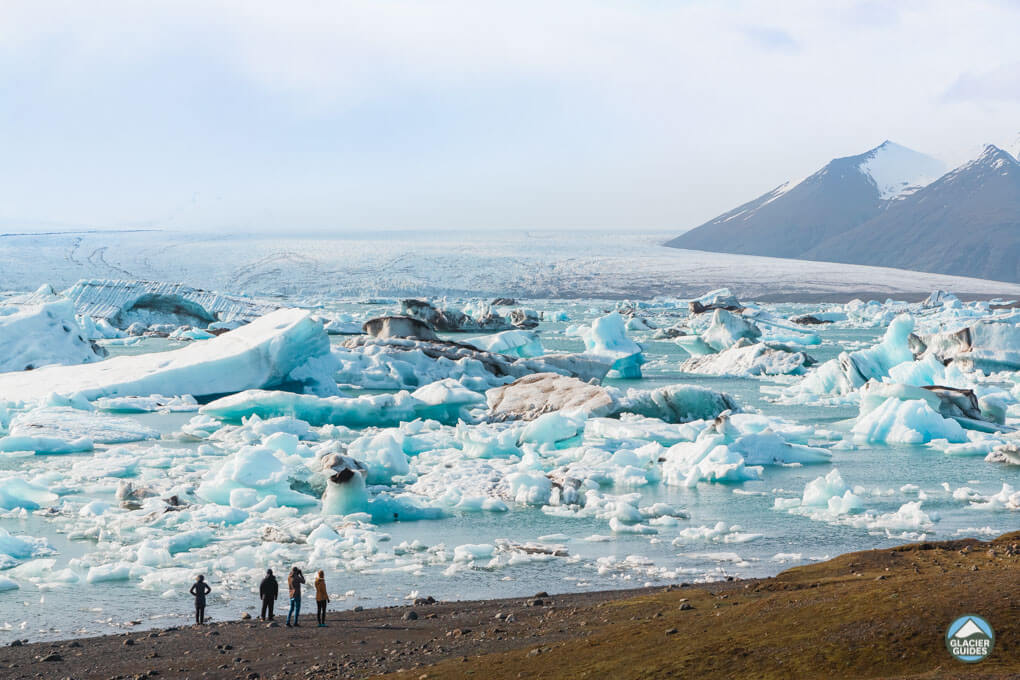
Visitors standing in front of the awe-inspiring icebergs at Jokulsarlon, South Icealnd
Nature in Iceland best demonstrates how glacier changes by its slow but constant flowing motion. When glaciers retreat, new lakes can start forming. Jokulsarlon wasn’t there when the early settlers arrived in Iceland. Now, its absolute popularity somehow overshadows other glorious glacial lakes that are essentially and equally valuable. The formation of each glacial lake is a unique process of the disappearing glacier.
You might ask what it means when glacial lakes start to form here and there. As the global temperature gets warmer, likely it’s more difficult for glaciers to escape the fate of shrinking. An increase in glacial lakes might mean there will be more water for the present time. But the question really is about sustainability. Because glacier don’t form in a short period of time. What will happen when its reliability as a source of water being threatened when glaciers continue to recede. There are questions we need to contemplate while we enjoy the incredible sceneries.
Where to Find Glacier Lagoons in Iceland?
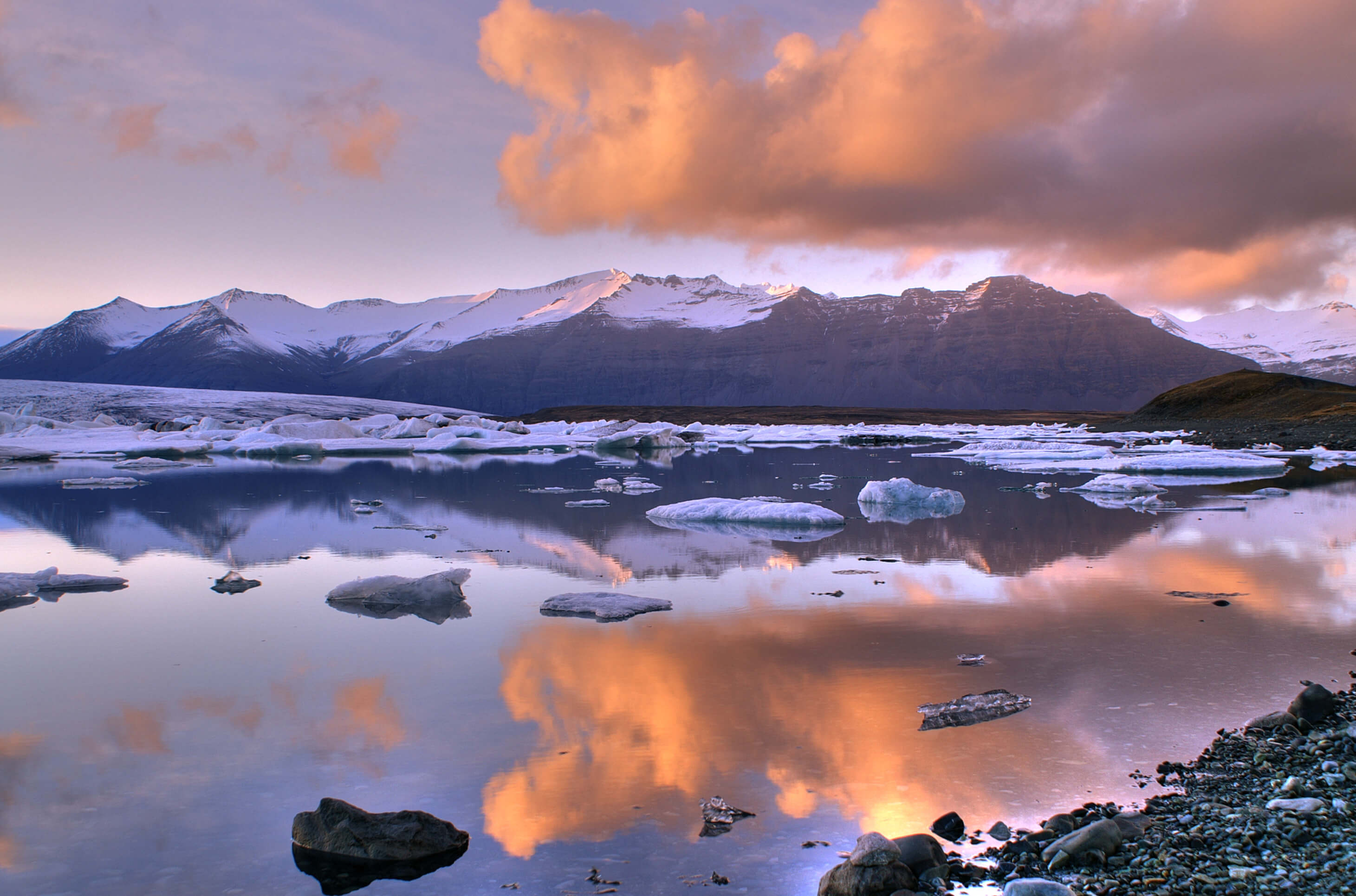
Jokulsarlon Glacier Lagoon at Sunset
Contacting a local guide for information about glaciers is always a good idea. A reliable and professional glacier guide is constantly updated on the most recent changes on glaciers, you can make the best of it by planning your trip with them. Below, you can find a map showing the location of each glacial lake we mentioned above and several glacier guiding services.
-------
